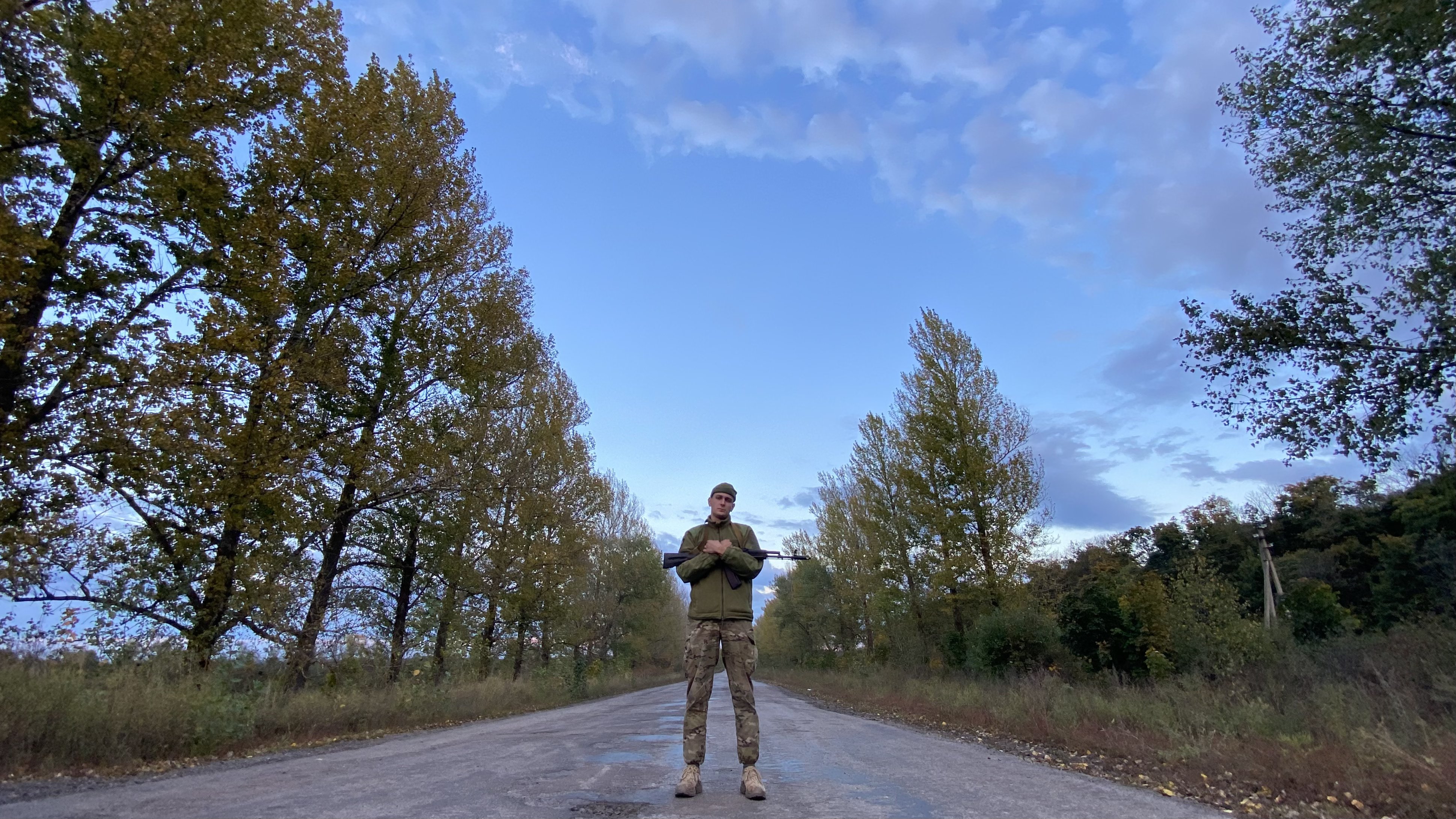Trained in the heat of battle: The journey of Kharkiv Oblast’s Territorial Defense

Editor’s Note: Some of the soldiers interviewed in this piece declined to give their last names for security reasons or because they had relatives in occupied territory, and are identified by first names and callsigns instead.
KHARKIV OBLAST – At an undisclosed part of the front line in Ukraine’s Kharkiv Oblast, orderly lines of trenches snake along a ridge looking across no-man’s land towards Russian positions.
The sight is a familiar one: dugouts, machine gun nests, deep gashes in the soil.
Compared to the front line in Donetsk Oblast though, this sector is quiet, with no sound of artillery to be heard. In front of the trenches, sappers work calmly in broad daylight to set up a new line of barbed wire, just in case.
These lines are manned by the 209th Battalion of Ukraine’s 113th Territorial Defense Brigade, the ranks of which are filled with locals from Kharkiv Oblast who enlisted in Ukraine’s Armed Forces at the outset of Russia’s full-scale invasion of Ukraine.
The soldiers here have been rotated back to their home region after over three months of brutal winter fighting in Donbas, where they took part in two of the fiercest battles the war has seen so far, around the cities of Bakhmut and Lyman.
Even though Russia isn’t attacking these new positions in Kharkiv Oblast, the contact line needs to be manned along its entire extent to protect against new incursions.
The Territorial Defense is a military reserve force originating in the informal volunteer battalions formed in response to Russia’s covert invasion of parts of eastern Ukraine in 2014.
Only in January 2022, with Russian troops and equipment gathering at the Ukrainian borders, was the reformed Territorial Defense Force officially incorporated into the structure of Ukraine’s Armed Forces.
These forces are the light infantry of the Ukrainian army, sometimes supported by the armoured vehicles and heavy artillery of other brigades but without any of their own.
The Territorial Defense are not the only units to have stepped up to the task of fighting in the toughest battles of the war.
Ukraine’s Border Guard Service, National Guard, and police formations have all taken part in the battles in Donbas, with the border guards in particular playing a key role in Ukraine’s defense of Soledar and Bakhmut in Donetsk Oblast.
But it is arguably those of the Territorial Defense that have undergone the most dramatic metamorphosis.
Since the days of sneaker-wearing green militia, Territorial Defense soldiers are now serving as a key component of Ukraine’s defense against Russia’s war, often performing some of the most unenviable tasks in their role as light infantry, holding the first line of defense against constant Russian bombardment and assaults.
Enemy at the gates
Located just 30 kilometers from the Russian border, Ukraine’s second-largest city of Kharkiv immediately came under fierce attack, as Russian forces looked to capture the city within a few days, much like the capital Kyiv.
All over Ukraine, tens of thousands of volunteers formed queues outside enlistment offices, many of whom were initially turned away as there was no way to immediately arm and organize them.
For the soldiers serving now in the 113th Brigade, taking up arms was not only a question of defending Ukraine itself, but of defending their own homes from immediate Russian attack.

Recalling the moment to the Kyiv Independent, every soldier had a different story of how exactly they joined, but one thread ran common: the lack of any question in their mind.
“From the very first days I realized that this would not be over in a matter of days or weeks, so I made the decision to go defend my dear Ukraine,” said 23-year-old Vitalii Pochabskyi, who worked in a warehouse before the war in Kharkiv.
“There were no doubts whether to go or not.”
“In the first days, people didn't have a choice, the aggression started and they had to go,” said Oleksii, a senior officer in his 40s.
“They were called by their heart and soul, they knew they had to defend their Kharkiv, because look, the enemy is at the gates.”

In the hectic early days of the battles around Kyiv and Kharkiv, photographs went viral of Territorial Defense volunteers, many of whom were very young men, patrolling the streets in civilian clothes, with no military personal equipment or protection besides the automatic rifle itself.
“Some of the guys had never held a weapon before,” recalled Oleksii. “On the second day of the war, we were heading to a key intersection on a bus because there was information that Chechens were trying to break through.”
“One guy just asked me how to use his rifle. He wasn't scared, he wasn’t making excuses, he just didn’t know. I showed him how the gun worked and off he went.”
After the initial blitzkrieg-style attack on Kharkiv stabilized, local Territorial Defense units settled into a support role behind Ukraine’s professional brigades.
“Others started fighting early on, but for me personally it was more gradual,” said Pochabskyi, “we helped with evacuation, with delivery of ammunition and food.”
From the frying pan into the fire
After almost all of occupied Kharkiv Oblast was liberated by Ukrainian forces in September, in which the 113th also took part, the unit was then sent to Donbas.
For many of the men, their first taste of how tough the fighting could really get came in the strategic settlement of Kurdiumivka south of Bakhmut, where soldiers of Russia’s Wagner paramilitary force had begun using their tactics of endless infantry assaults in an attempt to surround the city.
Assigned to hold the first line of defense as Territorial Defense units often are, the soldiers of the 209th Battalion soon found themselves fighting off Russian assaults at extremely close quarters.
“When you are in that kind of close contact you get to know yourself and others around you much better, you understand what a person is worth,” said Yevhen, a 36-year-old machine gunner who goes by his call sign “Zheka.”
As Russia stepped up offensive operations on Bakhmut and Lyman over winter, conditions on the front line became near unbearable.
“We rotated each other because of the cold,” said Dmytro, a 26-year-old infantryman. “If you haven't slept for two or three days because of the cold and you're also under attack, a normal person can’t handle it for long.”
“Once we were flooded and then the frost hit, now that was really hard, you're shivering all night and then the real fun would start in the morning.”
Here, soldiers learned specialized battlefield skills, some training as machine gunners, medics, and sappers among other roles.
Andrii Sokil, a 32-year-old native of the town of Bohodukhiv near the Russian border, started as a driver but retrained as a sapper in Donbas, performing vital logistics and fortifications jobs.
“Every time we go out on a job, one prays to God because you know you have children waiting at home,” he said. “It's scary, but what can you do?”
Between the unit’s two deployments to Donbas, Sokil got a rare chance to see his family, arriving just before New Year for the birth of his second daughter.
Oleksii adds that “when the real fighting began,” his fellow soldiers started to quickly learn in practice how and when to take cover, what sounds the different munitions make, and so on.
“These layers of knowledge built on top of each other, and these ordinary people became real warriors.”
In for the long haul
After the freezing, damp, and always under-fire trenches in Donbas, the unit’s current posting is one of relative rest and relaxation, though they could receive the order to return at any time.
Dugouts here, in Kharkiv Oblast, are equipped with stoves, generators, and Starlink satellite internet, while hot meals can be cooked and enjoyed.
“Compared to where we were before, here it really is like a rest, physically and emotionally,” said Zheka. “Here you don't see the constant horror that we and our brothers went through over there.”
“Of course we discuss what it was like back there, sometimes with a smile, sometimes recollecting the guys who were wounded,” he said, pausing to recollect his thoughts. “There is no way of getting around that.”

For Dmytro, the rest is appreciated, but brings with it a certain level of unease.
“Most of us are drawn back into the fight, because everyone watches the news,” he said.
“When you've been in the hottest places for a long time and suddenly you are faced with this quiet, mentally you start feeling like you're not doing enough. You feel useless, and want to go back, but that's just psychology.”
“If we need to go again we will go again, we are here to defend our country, not just to sit around,” added Zheka.
“We know ourselves how hard it is, how important it is to be switched out on time and not left there for too long to the point where you are counting the men you've got left on your fingers.”

In over a year of war, the Territorial Defense has done much to shed their reputation of amateurish reservists.
“People say Territorial Defense this and that,” Oleksii said, “but I can confidently say that there is no difference whatsoever; we have stood on the same level as mechanized brigades, completed the same missions, together with them and on our own.”
“Of course there are the Air Assault units and the Special Forces who are better trained and equipped, but when it comes to holding the line in the face of constant enemy assaults, we held our own without any issues.”
Note from the author:
Hi, this is Francis Farrell, cheers for reading this article. I grew up on the other side of the world, but in Ukraine I have found a home unlike any other. Just like with so many of our readers, I understand that you don't have to be from near here to realize how important Ukraine's struggle is for freedom and human rights all over the world. The Kyiv Independent's mission is to lead the way in continuing to bring the best homegrown, English-language coverage of this war, even if the rest of the world's attention starts to fade. Please consider supporting our reporting.


















